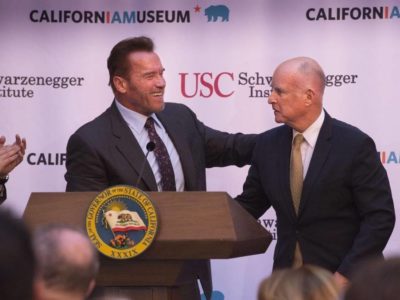Regulatory Policy
Defending the Environment in Dark Times
Where do we go from here?
Yesterday’s election didn’t turn out the way many of us hoped. The results may put in danger much of the progress made over the past eight years in addressing environmental issues and even risk some earlier accomplishments. What’s done is done, however, and we need to think about how to move forward. The Bush years …
Continue reading “Defending the Environment in Dark Times”
CONTINUE READINGHanging in the Balance: The Future of Environmental Law
10 huge questions that will be answered today.
By tomorrow morning, we should know a lot more about the future of environmental law — maybe, whether it has any future. We’ll certainly learn whether the U.S. will give up the fight against global warming. Whichever way you vote matters! Here are ten key questions we will be able to answer 24 hours from now: …
Continue reading “Hanging in the Balance: The Future of Environmental Law”
CONTINUE READINGTahoe Regional Planning Agency Wins Big in Ninth Circuit
U.S. Court of Appeals Rejects Challenge to TRPA’s Regional Plan
This week the Tahoe Regional Planning Agency (TRPA) won a major legal victory in the U.S. Court of Appeals for the Ninth Circuit. A unanimous three-judge panel of that court rejected environmentalists’ challenge to TRPA’s adopted Regional Plan for the Lake Tahoe Basin in Sierra Club v. Tahoe Regional Planning Agency. The Ninth Circuit decision effectively …
Continue reading “Tahoe Regional Planning Agency Wins Big in Ninth Circuit”
CONTINUE READINGObama’s Remarkable Environmental Achievements
When you look at the whole of his legacy, it’s a stunning record.
When he leaves office in January, President Obama will have compiled a remarkable record of environmental achievements. The record spans everything from climate change to endangered species and ocean protection. We can only hope that next Tuesday’s election doesn’t undo many of these gains. Here is a list, in no particular order, of twenty of …
Continue reading “Obama’s Remarkable Environmental Achievements”
CONTINUE READINGThe Environment and the Conservative Dilemma
Trump may shake up GOP’s anti-environmental coalition.
However this election comes out, conservatives face a major problem. As the ascendancy of Donald Trump shows, a substantial share of the GOP base – probably a majority — doesn’t care much about core conservative principles. Notably, Trump’s strongest allies, Rudy Giuliani and Chris Christie, do not have histories as staunch conservatives. This situation leaves …
Continue reading “The Environment and the Conservative Dilemma”
CONTINUE READINGGuest Bloggers Alice Kaswan and Kirsten Engel: Untapped Potential: Emissions Reduction Initiatives Beyond Clean Power Plan Are Warranted, Workable
New Report Analyzes Potential for Further Emissions Reduction from Existing Sources
Guest post by Alice Kaswan (University of San Francisco School of Law), Kirsten H. Engel (University of Arizona School of Law) It’s been a month since the D.C. Circuit heard oral arguments on the Clean Power Plan, and the nation is in wait-and-see mode. But our report, Untapped Potential: The Carbon Reductions Left Out of …
CONTINUE READINGOf Initiative Wars, Plastic Bags and Poison Pills
Deciphering California’s (Intentionally) Confusing Plastic Bag Propositions
California’s longstanding efforts to eliminate single-use plastic bags from the marketplace and the environment have finally reached California voters. The November 8th general election ballot contains a breathtaking 17 separate propositions–16 proposed initiative measures and one referendum measure. Propositions 65 and 67 both deal with the same subject–a proposed ban on single-use plastic bags. Those dueling measures …
Continue reading “Of Initiative Wars, Plastic Bags and Poison Pills”
CONTINUE READINGCalifornia’s Zero-Emission Vehicle Mandate In Need Of Reform
Long-term climate goals depend on addressing the current “glut” of compliance credits
California leads the nation in plug-in electric vehicle sales, with about 40% of the nationwide total happening in the Golden State. While some of that progress is related to the sheer market size here, much of it is due to state policies. And the biggest of those policies is the “zero emission vehicle” (or “ZEV”) …
Continue reading “California’s Zero-Emission Vehicle Mandate In Need Of Reform”
CONTINUE READINGA Stark Contrast: Clinton v. Trump on Climate Policy
Clinton wants to cut carbon emissions, Trump wants to raise them.
Forty percent of millennials don’t see a difference between Clinton and Trump on environment, energy, or climate policy. That’s just wrong — so wrong that it’s hard to believe anyone is that misinformed. The candidates are as different as day and night on those issues. As Paul Krugman said on Friday, “there is a huge, …
Continue reading “A Stark Contrast: Clinton v. Trump on Climate Policy”
CONTINUE READINGCelebrating California’s Climate Change Leadership
State Government Leaders From Both Parties Celebrate AB 32’s Tenth Anniversary
In stark contrast to a dysfunctional national government and an utterly dispiriting presidential campaign, Sacramento, California was today the site of an inspirational, bipartisan celebration. Current California Governor Jerry Brown, a Democrat, and his predecessor, Republican Governor Arnold Schwarzenegger, joined past and present state legislative leaders to commemorate the 10th anniversary of California’s landmark Global Warming Solutions Act of 2006, better known as …
Continue reading “Celebrating California’s Climate Change Leadership”
CONTINUE READING








